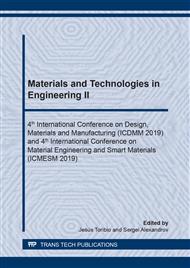[1]
Y. Saito, H. Utsunomiya, N. Tsuji, T. Sakai, Novel ultra-high straining process for bulk materials—development of the accumulative roll-bonding (ARB) process, Acta Mater. 47 (1998) 579–583.
DOI: 10.1016/s1359-6454(98)00365-6
Google Scholar
[2]
L. Su, C. Lu, G. Deng, K. Tieu, Microstructure and Mechanical Properties of AA5005/AA6061 Laminated Composite Processed by Accumulative Roll Bonding, Metall. Mater. Trans. B. 45 (2013) 515–522.
DOI: 10.1007/s11663-013-9869-x
Google Scholar
[3]
H. Alvandi, K. Farmanesh, Microstructural and Mechanical Properties of Nano/Ultra-fine Structured 7075 Aluminum Alloy by Accumulative Roll-Bonding Process, Procedia Mater. Sci. 11 (2015) 17–23.
DOI: 10.1016/j.mspro.2015.11.020
Google Scholar
[4]
H. Yu, C. Lu, A.K. Tieu, A. Godbole, L. Su, Y. Sun, M. Liu, D. Tang, C. Kong, Fabrication of ultra-thin nanostructured bimetallic foils by Accumulative Roll Bonding and Asymmetric Rolling, Sci. Rep. 3 (2013) 1–9.
DOI: 10.1038/srep02373
Google Scholar
[5]
R.S. V. G. Arigela , L. Lienshoeft1, P.Chekhonin, Comparative study of texture evolution in ARB processed AA2014, AA6063 and AA2014/6063 aluminium laminates, Kov. Mater. 53 2015 245–249.
DOI: 10.4149/km_2015_4_245
Google Scholar
[6]
S. Roy, B.R. Nataraj, S. Suwas, S. Kumar, K. Chattopadhyay, Accumulative roll bonding of aluminum alloys 2219/5086 laminates: Microstructural evolution and tensile properties, Mater. Des. 36 (2012) 529–539.
DOI: 10.1016/j.matdes.2011.11.015
Google Scholar
[7]
L. Su, C. Lu, A.K. Tieu, G. Deng, X. Sun, Ultrafine grained AA1050/AA6061 composite produced by accumulative roll bonding, Mater. Sci. Eng. A. 559 (2013) 345–351.
DOI: 10.1016/j.msea.2012.08.109
Google Scholar
[8]
S. Acharya, K.K. Ray, Assessment of tensile properties of spot welds using shear punch test, Mater. Sci. Eng. A. 565 (2013) 405–413.
DOI: 10.1016/j.msea.2012.12.068
Google Scholar
[9]
R. a L. Drew, C. a Leo, Small punch testing for assessing the tensile strength of gradient Al / Ni – SiC composites, Mater. Lett. 56 (2002) 812–816.
DOI: 10.1016/s0167-577x(02)00619-5
Google Scholar
[10]
M.L. Hamilton, F.A. Garner, M.B. Toloczko, S.A. Maloy, W.F. Sommer, M.R. James, P.D. Ferguson, M.R. Louthan, Shear punch and tensile measurements of mechanical property changes induced in various austenitic alloys by high-energy mixed proton and neutron irradiation at low temperatures, J. Nucl. Mater. 283–287 (2000) 418–422.
DOI: 10.1016/s0022-3115(00)00363-9
Google Scholar
[11]
S.M. Kurtz, C.W. Jewett, J.S. Bergström, J.R. Foulds, A.A. Edidin, Miniature specimen shear punch test for UHMWPE used in total joint replacements, Biomaterials. 23 (2002) 1907–(1919).
DOI: 10.1016/s0142-9612(01)00316-7
Google Scholar
[12]
P. Bahrami, A. Azizi, Investigation of Mechanical Properties for Commercial Purity Titanium Severely Plastic Deformed by Accumulative Roll-bonding Process, J. Mod. Process. Manuf. Prod. 6 (2017) 37–49.
Google Scholar
[13]
A. Shabani, M.R. Toroghinejad, Study on Texture Evolution and Shear Behavior of an Al/Ni/Cu Composite, J. Mater. Eng. Perform. (2018).
DOI: 10.1007/s11665-018-3692-0
Google Scholar
[14]
Y. Saito, H. Utsunomiya, N. Tsuji, T. Sakai, Novel ultra-high straining process for bulk materials development of the accumulative roll-bonding (ARB) process, Acta Mater. 47 (1999) 579–583.
DOI: 10.1016/s1359-6454(98)00365-6
Google Scholar
[15]
J. Dhyai Hassan, H. Ali, G.Y. Guney, On the mechanical behavior of accumulative roll bonded lightweight composite, Materials Research Express (2019).
Google Scholar
[16]
Z.P. Xing, S.B. Kang, H.W. Kim, Microstructural evolution and mechanical properties of the AA8011 alloy during the accumulative roll-bonding process, Metall. Mater. Trans. A Phys. Metall. Mater. Sci. 33 (2002) 1521–1530.
DOI: 10.1007/s11661-002-0074-9
Google Scholar
[17]
C. Lu, K. Tieu, D. Wexler, Significant enhancement of bond strength in the accumulative roll bonding process using nano-sized SiO2 particles, J. Mater. Process. Technol. 209 (2009) 4830–4834.
DOI: 10.1016/j.jmatprotec.2009.01.003
Google Scholar
[18]
V. Karthik, P. Visweswaran, A. Vijayraghavan, K. V. Kasiviswanathan, B. Raj, Tensile-shear correlations obtained from shear punch test technique using a modified experimental approach, J. Nucl. Mater. 393 (2009) 425–432.
DOI: 10.1016/j.jnucmat.2009.06.027
Google Scholar
[19]
G.L. Hankin, M.B. Toloczko, M.L. Hamilton, R.G. Faulkner, Validation of the shear punch-tensile correlation technique using irradiated materials, J. Nucl. Mater. 258–263 (1998) 1651–1656.
DOI: 10.1016/s0022-3115(98)00203-7
Google Scholar
[20]
M.B. Toloczko, R.J. Kurtz, A. Hasegawa, K. Abe, Shear punch tests performed using a new low compliance test fixture, J. Nucl. Mater. 307–311 (2002) 1619–1623.
DOI: 10.1016/s0022-3115(02)01258-8
Google Scholar


